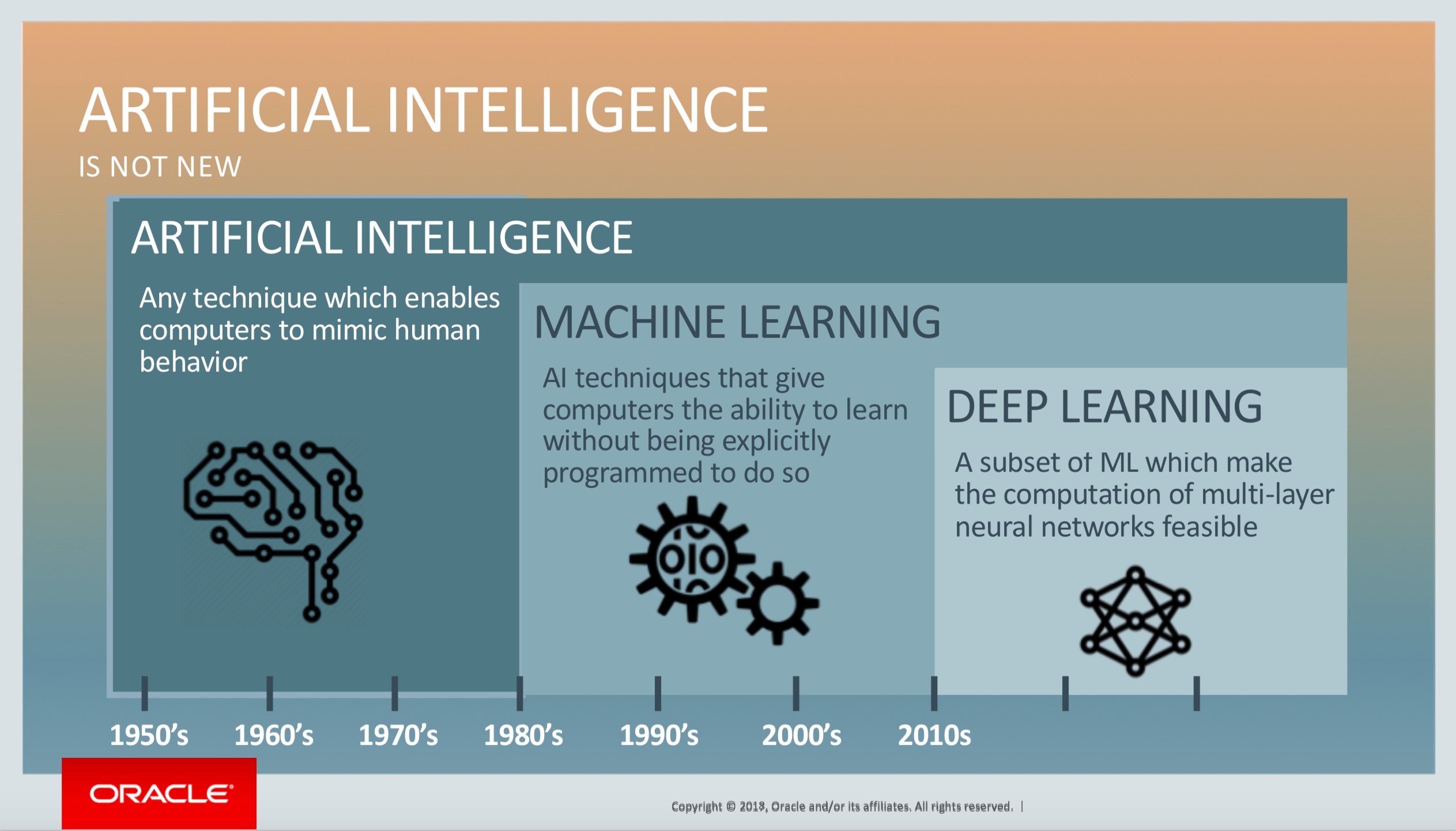AI,机器学习和深度学习之间有什么区别?
时间:2018-07-23 来源:Oracle 点击:
次
AI,机器学习和深度学习之间有什么区别?人工智能意味着让计算机以某种方式模仿人类的行为。机器学习是AI的子集,它包含使计算机能够从数据中找出事物并交付AI应用程序的技术。同时,深度学习是机器学习的一个子集,它使计算机能够解决更复杂的问题。
|
What's the Difference Between AI, Machine Learning, and Deep Learning?
AI,机器学习和深度学习之间有什么区别?
AI means getting a computer to mimic human behavior in some way.
Machine learning is a subset of AI, and it consists of the techniques that enable computers to figure things out from the data and deliver AI applications.
Deep learning, meanwhile, is a subset of machine learning that enables computers to solve more complex problems.
What Is AI?
Artificial intelligence as an academic discipline was founded in 1956. The goal then, as now, was to get computers to perform tasks regarded as uniquely human: things that required intelligence. Initially, researchers worked on problems like playing checkers and solving logic problems.
If you looked at the output of one of those checkers playing programs you could see some form of “artificial intelligence” behind those moves, particularly when the computer beat you. Early successes caused the first researchers to exhibit almost boundless enthusiasm for the possibilities of AI, matched only by the extent to which they misjudged just how hard some problems were.
Artificial intelligence, then, refers to the output of a computer. The computer is doing something intelligent, so it’s exhibiting intelligence that is artificial.
The term AI doesn’t say anything about how those problems are solved. There are many different techniques including rule-based or expert systems. And one category of techniques started becoming more widely used in the 1980s: machine learning.

What Is Machine Learning?
The reason that those early researchers found some problems to be much harder is that those problems simply weren't amenable to the early techniques used for AI. Hard-coded algorithms or fixed, rule-based systems just didn’t work very well for things like image recognition or extracting meaning from text.
The solution turned out to be not just mimicking human behavior (AI) but mimicking how humans learn.
Think about how you learned to read. You didn’t sit down and learn spelling and grammar before picking up your first book. You read simple books, graduating to more complex ones over time. You actually learned the rules (and exceptions) of spelling and grammar from your reading. Put another way, you processed a lot of data and learned from it.
That’s exactly the idea with machine learning. Feed an algorithm (as opposed to your brain) a lot of data and let it figure things out. Feed an algorithm a lot of data on financial transactions, tell it which ones are fraudulent, and let it work out what indicates fraud so it can predict fraud in the future. Or feed it information about your customer base and let it figure out how best to segment them. Find out more about machine learning techniques here.
As these algorithms developed, they could tackle many problems. But some things that humans found easy (like speech or handwriting recognition) were still hard for machines. However, if machine learning is about mimicking how humans learn, why not go all the way and try to mimic the human brain? That’s the idea behind neural networks.
The idea of using artificial neurons (neurons, connected by synapses, are the major elements in your brain) had been around for a while. And neural networks simulated in software started being used for certain problems. They showed a lot of promise and could solve some complex problems that other algorithms couldn’t tackle.
But machine learning still got stuck on many things that elementary school children tackled with ease: how many dogs are in this picture or are they really wolves? Walk over there and bring me the ripe banana. What made this character in the book cry so much?
It turned out that the problem was not with the concept of machine learning. Or even with the idea of mimicking the human brain. It was just that simple neural networks with 100s or even 1000s of neurons, connected in a relatively simple manner, just couldn’t duplicate what the human brain could do. It shouldn't be a surprise if you think about it; human brains have around 86 billion neurons and very complex interconnectivity.
|
相关文章
- 机器学习产业Longlist长名单(TOP44) 机器学习 人工智能 标杆企业
- 全球及中国机器学习行业发展研究报告(2022年新版) 机器学习 人工智能 机器学习报告
- 《全球机器学习行业技术及市场前景展望报告》(全球技术及市场版) 机器学习 人工智能 机器学习报告
- Oracle:什么是机器学习? 机器学习 人工智能 深度学习
- 人工智能,机器学习和深度学习之间有什么区别? 人工智能 机器学习 深度学习 AI GPU
- CITE2024借助深圳电子信息产业的蓬勃发展,顺势而上 电子 电子信息 展会论坛
- 2024九峰山论坛暨中国国际化合物半导体产业博览会 化合物半导体 半导体 半导体材料 展会论坛
- CHInano 2024 第十四届中国国际纳米技术产业博览会 纳米 展会论坛 微纳制造MEMS
- 全球及中国机器视觉行业研究报告(2023-2024年) 机器视觉 机器视觉报告 研究报告
- 移动机器人(agv/amr)行业发展研究报告(2024-2025年) AGV AGV报告 移动机器人 移动机器人报告 AMR AMR报告 研究报告
- 机器视觉市场前景及AI+应用洞察研究报告(2024) 机器视觉 机器视觉报告 研究报告
- 中国机器视觉行业主要政策汇总 机器视觉 政策 产业政策
- IIM信息:2025-2030年工业自动化行业研究报告(2024) 研究报告 工业自动化 自动化报告 工业自动化报告
- SEMI-e第六届深圳国际半导体暨应用展览会(SEMI-e) 汽车半导体 IGBT Al算力 算法 展会论坛
- 华为、中芯国际亮相,大湾区迎来“新”风潮! 芯片 半导体 展会论坛
- 信创产业链条上的“明珠”企业集体亮相CITE2024 信创 电子信息 展会论坛
- NEPCON China2024 中国国际电子生产设备暨微电子工业展 电子 SMT 微电子 展会论坛
- 全球及中国人工智能行业产业链发展研究报告(2024-2025) 人工智能 人工智能报告 研究报告 AI报告
- 电池管理系统(BMS)市场调查与技术发展趋势报告(2024-2025) BMS 电池管理系统 BMS报告 电池管理系统报告 研究报告
- 2024年中国(上海)机器视觉展Vision China-报名入口 机器视觉 机器视觉报告 机器视觉 机器视觉报告
- 机器视觉产业链大数据及AI+应用洞察研究报告(2024) 机器视觉 机器视觉报告 研究报告 大数据
- 家电零部件展丨家电配件展丨CAEE家电制造业供应链展览会 智能家电 智能家居 展会论坛
- IIM信息:基站行业研究报告(2024-2025年) 基站 研究报告 基站报告
- 第104届中国电子展(国际元器件暨信息技术应用展) 展会论坛 电子 电子信息 集成电路 汽车电子
- 第12届中国(西部)电子信息博览会 展会论坛 电子 电子信息 集成电路 汽车电子
- 以展促产 向新而行!第十二届中国电子信息博览会圆满落幕 电子 电子信息 集成电路 汽车电子 展会论坛
- 2024北京机器视觉助力智能制造创新发展大会 机器视觉 智能制造
- 2024中国机器视觉展 机器视觉
- 深圳国际电子元器件及物料采购展览会(ES SHOW) 电子元器件 智能网联汽车 智能工厂 工业自动化 展会论坛
- IOTE 2024第22届国际物联网展·深圳站邀请函 物联网 展会论坛
- VisionChina(上海)2024特色活动 机器视觉
- 中国(上海)机器视觉展VisionChina2024观众预登记进行中! 机器视觉
- IIM信息:智能制造行业洞察分析报告(2024) 智能工厂 智能制造 智慧工厂 智能工厂报告 智慧工厂报告 智能制造报告
- IIM发布:基站行业分析研究报告(2024-2025年) 基站 研究报告 基站报告
- 四部门关于印发国家人工智能产业综合标准化体系建设指南(2024版)的通知 人工智能 AI 政策 产业政策
















 京公网安备 11010602104466号
京公网安备 11010602104466号